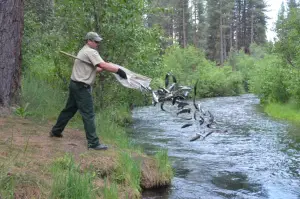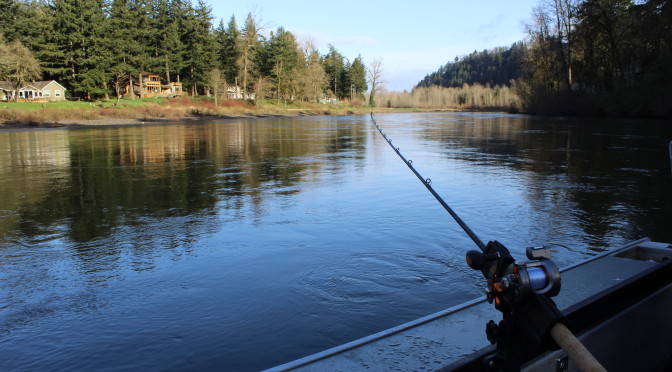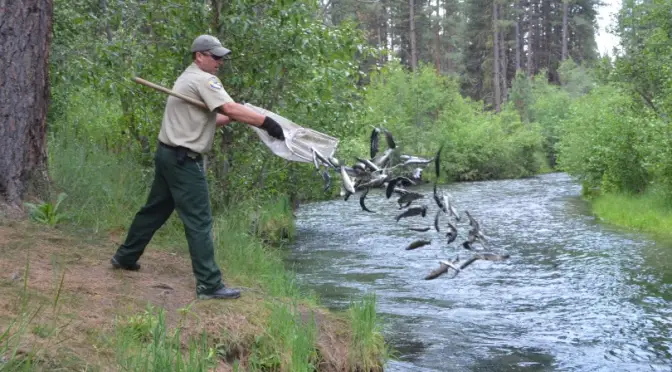Search
Latest Articles
Hatchery Steelhead WA vs. ID
by Robert Deen for Anglers Club Magazine, February 28, 2016
Pacific Northwest Fishing Organizations Tangle Over Lawsuit Targeting Hatcheries
By Robert Deen
The wild vs. hatchery controversy produced yet another lawsuit on February 16 as Pacific Northwest fishing organizations exchanged angry words and petitioned Washington D.C. for action.
Five organizations led by the Wild Fish Conservancy filed suit against the National Marine Fisheries Service (NMFS) for failing to complete a recovery plan for Threatened Puget Sound steelhead.
Opponents claim the lawsuit (and similar ones) would shut down regional fish hatcheries that produce 90% of the steelhead and salmon caught in the Pacific Northwest.
“It’s been over eight years since Puget Sound steelhead were listed as threatened, “said Kurt Beardslee, executive director of Wild Fish Conservancy. “NOAA just announced it would be at least another four years, making it twelve years or more in total until they have completed the final recovery plan. Major decisions are already being made in the absence of this plan, including determinations on the levels of harm that are deemed acceptable from hatcheries, what rivers are going to be managed for wild steelhead, and which important steelhead habitats must be protected and restored.
In addition to the Wild Fish Conservancy, the lawsuit is supported by The Conservation Angler, International Federation of Fly Fishers Steelhead Committee, Washington Fly Fishing Club, and the Wild Steelhead Coalition.
Opposing the lawsuit and similar ones is the Northwest Sportfishing Coalition, comprised of “regional recreational fishing organizations, businesses and individuals working together to conserve and enhance our fisheries.” The group is funding a “Save our Hatcheries” lobbying effort, with supporting organizations including Fish Northwest, Coastal Conservation Association Washington, Washington Anglers PAC, Puget Sound Anglers and the Northwest Sportsfishing Industry Association.
That group claims the lawsuit aims to shut down the more than 150 salmon and steelhead hatchery programs across Washington State that recreational anglers depend on, and which contribute more than $1 billion to the region’s economy.
 photo credit CDFW
photo credit CDFW“A special interest group, acting on behalf of narrow interests, has filed federal lawsuits seeking to take advantage of procedural loopholes to close down dozens of hatcheries,” states the group’s website.
Save Our Hatcheries
Save Our Hatcheries is asking supporters to sign a petition at their website, www.saveourhatcheries.org According to a statement on the website of CCA Washington, a Save Our Hatcheries member, “The Wild Fish Conservancy has earned the ire of recreational anglers, tribes, and others through their systematic pursuit of anti-hatchery litigation. WFC is unabashedly anti-hatchery in their beliefs, with their current Director of Science and Research, Jamie Glasgow, being quoted as responding to Sen. Kirk Pearson when asked which hatchery programs he would support, “there are several that have closed over time – those would be ones that we support.”
Wild vs. Hatchery
Numerous lawsuits over the past few years in the Pacific Northwest highlight growing controversy over the practice of raising salmon and steelhead in hatcheries and releasing them into the wild. Wild fish supporters argue that hatcheries harm wild fish populations, while supporters point to the critical role hatcheries play in supporting sport and commercial fishing. Most hatcheries are devoted to turning out fish for fishermen to catch.
Salmon and steelhead are tremendously important in the Pacific Northwest; of cultural and nutritional significance to tribes, job creators for commercial fishermen and big draws for recreational anglers.
Thirteen species of salmon and steelhead listed as endangered or threatened under the Endangered Species Act in the Columbia River basin. According to the National Marine Fisheries Service (NMFS) Puget Sound wild steelhead numbers are at 3% of their historical abundance, with component populations facing a high risk of extinction.
Meanwhile, in Idaho…
Idaho Needs Your Help, but It’s a Favor We’re Grateful to Give
By Robert Deen
The Idaho Department of Fish and Game is calling on fishermen to catch steelhead from the South Fork of the Clearwater River for their hatchery program.
Catch Steelhead Spawners
Fish and Game wants young steelhead released into the river to come from parents taken from the river, so the department is recruiting anglers to catch local spawners to provide stock for nearby hatcheries. The Clearwater River is located in west central Idaho near Lewiston. To sweeten the pot, steelhead caught under the program don’t count against the angler’s bag limit.

Here’s how the program works: anglers catch steelhead and place them carefully into perforated sections of PVC pipe (provided by Fish and Game). The pipe is returned to the river and tethered. Fish and Game crews retrieve the fish and move them to hatcheries by tanker truck. The PVC pipes are placed at popular fishing holes along the South Fork during the peak fishing times of late February and March.
Typically weirs, a sort of water fence, are placed in rivers to trap and collect adult steelhead to meet hatchery needs, but this is not an option in the South Fork. The Department relies entirely on anglers to provide spawners. Last year 350 steelhead were captured under the program, producing an estimated one million smolts for release. This year’s goal is 600 fish.
According to Fish and Game biologists, hatchery steelhead smolts survive and return as adults at a higher rate when their parents come from the exact stream where the young fish are released. So using local broodstock should mean more adult steelhead returning for anglers, even with the same number of smolts released. These fish should also adapt more easily to the unique environment of the South Fork and maintain the traits that have made Clearwater steelhead such a popular fishery.
Reprinted with permission of Anglers Club Magazine.


